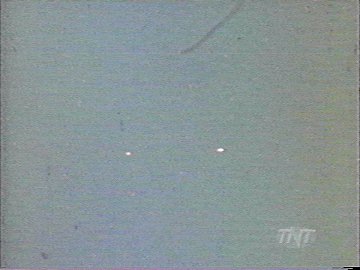
The Montana Film - The Early Analyses

Cropped blow-up of one of the first frames

|
The earliest analyses of the Montana Film (then Top Secret)
were conducted by the United States Air Force and the U. S. Navy. After
the films were declassified they were used in a UFO documentary in 1956
by Green Rouse. Here is what the documentation showed.
Francis Ridge
NICAP Site Coordinator
----------
1. The objects appear to be a light source rather than
reflected light.
2. All the objects appear to be the same size and
circular in shape.
3. The general color of the objects seems to be
bluish-white.
4. If the distance is estimated to be 5 miles and the
movement perpendicular
to the line of sight, the velocity
noted is 653.5 mph; likewise, at 2-1/2 miles
distant the average speed is 326.75
mph.
5. Generally the movement in flight appears to follow
an elliptical or circular
pattern, within the group.
While the objects remain unidentified the following
possibilities have been ruled out:
1.
Balloons
2. Aircraft
3. Birds
Objects within five miles would have easily been
identified. Objects in excess of five miles would be traveling
faster than aircraft can achieve, except in straight-line speed runs.
Source: Air Force report to Green-Rouse Productions, figures
used in motion picture documentary, 1956, "U.F.O."
----------
(Dr. Robert L. Baker, Jr., was a consultant to the
Douglas Aircraft Company, former head of Lockheed's Astrodynamics
Research Center, project officer on a number of classified Air Force
projects, and (at the time) a senior scientist with the Computer
Sciences Corporation).
Dr. Robert L. Baker:
My initial contact with anomalistic observational phenomena
- AOP - came in 1954 when I was a consultant to Douglas Aircraft Co. in
Santa Monica, Calif., serving as special assistant to Dr. W. B.
Kiemperer, director of Douglas' research staff. The data consisted of
two short film clips: one taken in Montana - termed by us as the
Montana film-and one taken in Utah - called by us the Utah film. These
films were provided to us by the Air Technical Intelligence Center -
ATIC, now the Foreign Technology Division - FTD - at Wright-Patterson
Air Force Base; 35-millimeter prints were furnished by Green-Rouse
Productions of Samuel Goldwyn Studios.
Both films had been taken by apparently reliable and
unbiased men using amateur movie cameras and, in each case, there was a
credible, substantiating witness present. The films exhibited the
motion of rather fuzzy white dots, but the Montana film was remarkable
in that foreground was visible on most of the frames.
Preliminary analysis excluded most natural phenomena. More
detailed study indicated that the only remaining natural phenomenon
candidate for the Utah film was birds in flight, and for the Montana
film it was airplane fuselage reflections of the sun. After about 18
months of rather detailed, albeit not continuous, study using various
film-measuring equipment at Douglas and at UCLA, as well as analysis of
a photogrammetric experiment, it appeared that neither of these
hypothesized natural phenomena explanations had merit, and a report was
published by me (Baker [1956] )and forwarded to Brig. Gen. Harold E.
Watson, commander, ATIC. Since the description of the circumstances of
the filming and the analyses of the data provided on the films is
rather lengthy, and have since been published in the open literature,
it does not seem unreasonable to repeat the analyses here.
<snip>
To this date my analyses of anomalistic motion picture data
have been rather ungratifying. Although I am convinced that many of the
films indeed demonstrated the presence of anomalistic phenomena, they
all have the characteristic of rather ill-defined blobs of light, and
one can actually gain little insight into the real character of the
phenomena. For example, linear distance, speed, and acceleration cannot
be determined precisely, nor can size and mass. As I will discuss in a
moment, this situation is not particularly surprising, since, without a
special-purpose sensor system expressly designed to obtain information
pertinent to anomalistic observational phenomena, or a general-purpose
sensor system operated so as not to disregard such data, the chance for
obtaining high-quality hard data is quite small.
Source: Hearings before the
Committee on Science & Astronautics, July 29, 1968, page 127
|